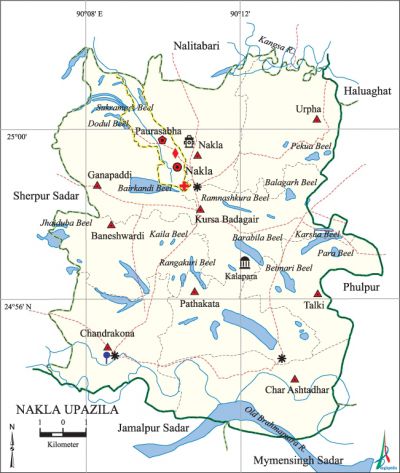Nakla Upazila
Nakla Upazila (sherpur district) area 173.84 sq km, located in between 24°53' and 25°02' north latitudes and in between 90°07' and 90°15' east longitudes. It is bounded by nalitabari upazila on the north, jamalpur sadar and mymensingh sadar upazilas on the south, phulpur and haluaghat upazilas on the east, sherpur sadar upazila on the west.
Population Total 189685; male 92895, female 96790; Muslim 185666, Hindu 3959, Christian 32 and others 28.
Water bodies Main rivers: old brahmaputra, kangsa; Karsha Beel, Bairkandi Beel, Barabila Beel are notable.
Administration Nakla Thana, now an upazila, was formed in 1930.
| Upazila | ||||||||
| Municipality | Union | Mouza | Village | Population | Density (per sq km) | Literacy rate (%) | ||
| Urban | Rural | Urban | Rural | |||||
| 1 | 9 | 79 | 108 | 33086 | 156599 | 1091 | 52.6 | 41.0 |
| Municipality | ||||||||
| Area (sq km) |
Ward | Mahalla | Population | Density (per sq km) |
Literacy rate (%) | |||
| 16.41 | 9 | 16 | 33086 | 2016 | 52.6 | |||
| Union | ||||
| Name of union and GO code | Area (acre) | Population | Literacy rate (%) | |
| Male | Female | |||
| Urpha 85 | 4724 | 9820 | 9997 | 37.5 |
| Gourdwar 47 | 2305 | 4590 | 4855 | 42.6 |
| Ganapaddi 38 | 4613 | 10271 | 10735 | 39.4 |
| Chandrakona 19 | 5105 | 11133 | 11519 | 44.5 |
| Char Ashtadhar 28 | 5649 | 9613 | 10145 | 34.6 |
| Talki 76 | 3544 | 7436 | 7612 | 48.3 |
| Nakla 57 | 4902 | 7962 | 7989 | 39.1 |
| Pathakata 66 | 4319 | 9025 | 9656 | 44.9 |
| Baneshwardi 17 | 3744 | 6911 | 7330 | 39.5 |
Source Bangladesh Population Census 2011, Bangladesh Bureau of Statistics.

Archaeological heritage and relics Kalapara Mosque (18th century).
War of Liberation Freedom fighters had encounters with the Pakistan army at Narayankhola, Gauraddar, Boroitar, Chandrakona and some other places of the upazila. 20 freedom fighters were killed in these encounters. Nakla upazila was liberated on 9 December.
For details: see নকলা উপজেলা, বাংলাদেশ মুক্তিযুদ্ধ জ্ঞানকোষ (Encyclopedia of Bangladesh War of Liberation), বাংলাদেশ এশিয়াটিক সোসাইটি, ঢাকা ২০২০, খণ্ড ৫।
Religious institutions Mosque 218, temple 4, church 1, tomb 3. Noted religious institutions: Kalapara Mosque, Nakla Bazar Bara Jami Mosque, Upazila Parishad Mosque, Nakla Bazar Mandir.
Literacy rate and educational institutions Average literacy 43.0%; male 44.7%, female 41.5%. Educational institutions: college 4, technical college 1, secondary school 33, primary school 97, madrasa 18. Noted educational institutions: Nakla Haji Jal Mamud College (1972), Chowdhury Sabrunnessa Mahila Degree College (1994), Chandrakona Rajlaxmi High School (1919), Afzalussena Girls' High School (1922), Nakla Pilot High School (1947), Nakla Pilot Girls' High School (1964), Pachkahunia Senior Madrasa (1931).
Cultural organisations Library 3, club 27, cinema hall 1, women's organisation 30, lalitakala academy 1, playground 12.
Main sources of income Agriculture 69.40%, non-agricultural labourer 3.48%, industry 0.98%, commerce 10.67%, transport and communication 3.19%, service 3.86%, construction 0.89%, religious service 0.11%, rent and remittance 0.19% and others 7.23%.
Ownership of agricultural land Landowner 60.77%, landless 39.23%; agricultural landowner: urban 50.44% and rural 61.30%.'
Main crops Paddy, jute, sugarcane, wheat, maize, pulse, onion, garlic, turmeric, vegetables.
Extinct or nearly extinct crops Local varieties of paddy, sesame, sweet potato, arahar.
Main fruits Mango, blackberry, banana, jackfruit, litchi, papaya, plum, guava.
Fisheries, dairies and poultries Fishery 6, dairy 39, poultry 35, hatchery 2.
Communication facilities Pucca road 106 km, semi-pucca road 2 km, mud road 414 km.
Extinct or nearly extinct traditional transport Palanquin, horse carriage, bullock cart.
Noted manufactories Flour mill, rice mill, chira mill, saw mill, oil mill, ice factory, welding factory.
Cottage industries Goldsmith, blacksmith, potteries, weaving, cane work, bamboo work, wood work, tailoring.
Hats, bazars and fairs Hats and bazars are 26, fairs 3, most noted of which are Nakla, Chandrakona and Narayankhola hats.
Main exports Sugarcane molasses, banana, onion, garlic, turmeric.
Access to electricity All the unions of the upazila are under rural electrification net-work. However 38.1% of the dwelling households have access to electricity.
Sources of drinking water Tube-well 96.1%, tap 0.3% and others 3.6%. The presence of arsenic has been detected in shallow tube-well water of the upazila.
Sanitation 65.3% of dwelling households of the upazila use sanitary latrines and 24.7% of dwelling households use non-sanitary latrines; 10.0% of households do not have latrine facilities.
Health centres Upazila health complex 1, satellite clinic 1, family planning centre 9, clinic 2.
Natural disasters The devastating cyclones of 1584, 1822, 1960 and 1970 and the flood of 1876 caused huge loss of life and damages to settlements, livestock and other properties of the upazila.
NGO activities Operationally important NGOs are brac, asa, CIDA. [Muhammad Harunur Rashid]
References Bangladesh Population Census 2001 and 2011, Bangladesh Bureau of Statistics; Cultural survey report of Nakla Upazila 2007.
